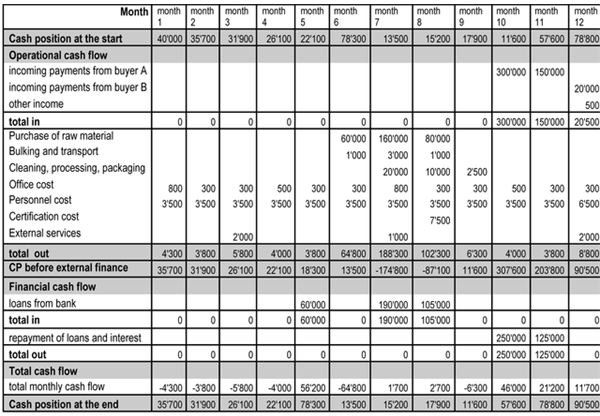25 Ways to Help You Achieve Cash Flow Management Expertise
Why Managing Cash is Necessary
Many the business owner fear the words “cash flow”—most likely because they wonder where they’ll get the cash they need to keep their doors open. Cash flow is necessary to fund inventory, make vendor and loan payments and pay operating expenses such as rents, utilities and especially—your employees. There’s no secret to managing working capital but for some it can be challenging. This guide takes the guesswork out of the process.
What are the goals of cash flow management, how does a business owner find ways to fund cash flow and what is cash flow benchmarking? What financial statements are essential tools you need to know the ins and outs of before making cash decisions? Do you know how to predict sales; cost of sales and expenses to determine your cash flow—if not find free downloadable templates you can start using now. Lastly, we offer some best practices such as keeping track of your payables and receivables and motivational tools to keep your business on track to ensure that needed cash flow is always at acceptable levels.
Learning the Basics

Let’s assume you are a new entrepreneur and need to learn about cash flow before you open your business doors, although all of the following posts are great pieces to bookmark and share with business owner friends.
This is a great guide that explains what cash flow is and why it’s important to manage your money even when times are tight. What happens when your business has unforeseen expenses or sales are so low you have no cash coming in? Why is it necessary to always keep your bank account balances in your head as a small business owner? When cash is low, why is it bad to rob Peter to pay Paul? All of these questions are answered with essential tips for keeping your cash flowing.
Startup businesses need to develop a cash flow forecast to reveal the amount of cash available at the end of each and every month. Here, you’ll find out how to do this along with a free template to help you get started. Learn what cash inflows and outflows are and how to predict them accurately. For new business owners, find out how to determine expenses for operating expenses such as rent, utilities and paying employees. Upon completion of this article, you’ll have a cash flow forecast you can use to manage your cash.
The Importance of Cash Flow Proformas
Our article above in this guide explained what cash flow forecasts are, but if after reading, you feel you can skip this step, here you’ll learn why you absolutely can’t and why cash flow forecasts and proformas are essential. Not only do these financial tools allow you to look at money coming in and going out in black and white, they are important to complete and analyze on a monthly, quarterly or annual basis.
Cash Flow to Fund Your Business
Using cash flow forecasts to help fund your business is the one of the first steps in expert cash flow management. Learn what banks, lenders and investors look for before they offer up needed cash and ways to use forecasts to entice funding. Will investors want a percentage of your business in return for needed cash and if so, should you allow the percentage to be higher than yours? Do banks want collateral for loans and how much? The mystery behind cash flow funding will be gone once you read this informational post.
Manage Your Cash Flow With These Tools
A step-by-step guide to learn where you cash is going, how to manage it more effectively using the right tools, and ways to reduce expenses to increase your bottom line. Why are cash flow comparisons so important and can bad inventory control break your business? Where should you cut expenses and above all, when and where do you go for help when things really look grim? Find out in this great management article.
Learn effective ways to improve cash flow with these top ideas such as paying attention to your receivables, offering payment incentives and working with vendors to gain the highest discounts. Often, using these ideas are useful when sales are slow to ensure cash flow keeps coming in. Things like buying in bulk from vendors, taking advantage of stock days where all vendors offer discounts and using some accounts receivable best practices make your cash outlook better and more manageable.
Managing cash flow isn’t always just about what your business is doing but what your competitors are doing and industry trends. This is called cash flow benchmarking and here you’ll learn how to use this tool effectively. In benchmarking, your competitors aren’t your enemies but needed assets. Learn why working within groups of similar business owners helps each participant learn what they’re doing right or wrong and how to improve their “benchmark.”
Part of recognizing the importance of cash flow management is coming up with unique ideas on ways to keep cash readily available to aid you in paying all your expenses. Find top ideas here; some of which may surprise you such as stocking up on fast-moving inventory and asking your suppliers to provide you with lists of top sellers, even if your competitor is selling the same thing. You can always discount your items a few pennies to achieve more cash and these ideas are sure winners!
The cash flow management basics above are key in running and maintaining your business, but what other financial tools can you use to help you determine where cash is coming from and where it’s going?
An In-Depth Look at Financials to Manage Cash Flow

The next articles will guide you through some of the most important financial tools you’ll be working with to manage cash flow.
From the balance sheet to the income statement to the expense statement to your monthly trial balance, learn why these financial reports reveal information you need to keep cash on hand. Each of these financial tools have different purposes, but they all tie together in the end to show the net worth of your business and how much cash on hand you have available. Learn why it’s important to know everything you can about using and reading these financial tools.
Using Financial Statements to Make Cash Decisions
Now that you understand the different types of financial statements, learn more about how each of these are utilized to make business decisions that affect cash flow. For example, if your income and expense statement shows a loss each month, where on that statement can you slash expenses or increase revenues? Or, can you allocate expenses to different departments so your bottom line looks more attractive? Financial accounting knowledge is king in the cash flow world and this post ensures you become an expert on analyzing and making great decisions.
Find a free template for an income statement along with easy to understand direction on how to prepare an income statement showing all revenues and expenses, eventually showing your profit or loss and cash available at month end. Many business owners rely on hand-prepared general ledgers and often mistakes are made. With this free Microsoft Excel template, which automatically calculates once revenues and expenses are entered, you’ll never make a mistake again.
Income Statements vs. Balance Sheets
While the balance sheet is considered a snapshot of your business, the summary totals on your balance sheet are pulled from income statements. The balance sheet may say you have $5,000 in accounts receivables, but how many of those receivables are past due or uncollectible and should be written off? What about aged inventory? Digging deeper into the balance sheet summary totals will show old inventory. Your payables may look low on the balance sheet but can you tell if some are late? Learn here how to effectively use both these tools to dig deeper into your accounts.
Another important financial tool is the general ledger where every transaction in your business is posted via debits and credits. Find a free Microsoft Excel template here and tips on how to use it. General ledgers don’t have to be a mystery anymore and how they are utilized is easily learned in this how to article. If you don’t have an accounting software package, this is a good place to start. Stop using hand-written general ledgers and start using tools to minimize mistakes.
Learning how to prepare a general ledger so the right numbers pull to your income and expense statements, which ultimately reveal your profit or loss (and cash on hand) is essential to cash flow management and here, we’ll walk you through how to complete this process. The template is free and we go more in-depth on how to create your general ledger and what should go where. Learn about debits and credits and typical journal entries in this must-read post.
Hidden Secrets of the Trial Balance
Every transaction posted in your general ledger including cash ins and outs are pulled to the trial balance, which is the most asked item of a financial statement by accountants and tax professionals. Find out what it is and what it reveals as far as cash flows. While everything posted in the general ledger pulls to the trial balance, especially in accounting software programs, within the trial balance you can drill in deep to see and correct errors by making adjusting journal entries so you fear the trial balance no more!
Learn How to Prepare a Trial Balance
Now that you know the secrets of the trial balance, here you’ll find tips on how to prepare one, why it must balance and what to do if it doesn’t to ensure everything posted in your general ledger posts correctly to your income and expense statement. What are adjusting journal entries and how do you post them so they affect the trial balance? Is there a difference between a trial balance and an adjusted trial balance? You bet and if you don’t know the ins and outs of this important financial tool, don’t worry because we explain it here.
These financial tool basics are necessary for creating your ultimate goal—the income and expense statement which reveals your cash in the bank and all available cash. However, what else can you do to help better manage your cash flow?
Best Practices

In most companies there are accounts payables and receivables and by using some best practices, you’ll get a better handle on keeping your cash in control.
You must have cash to pay your expenses and accounts payables, and here you’ll learn seven of the best practices to ensure you have the cash to pay those accounts. Did you know some vendors offer discounts if you pay early or use electronic bank transfers to pay your payables in full on the day they are due? Don’t scramble trying to decide who to pay by taking the time to schedule and to control your accounts payables within your accounting software system to learn when each are due and pay on a timely basis.
If you follow the tips here on how to improve your accounts receivable percentages, you’ll turn those outstanding accounts into cash, and cash is what you need to stay afloat. Does your business offer a discount to customers who pay early or on time? What about charging late fees or interest for those who don’t pay on time? Implementing both of these practices are just two ways you can improve your receivables to ensure cash is coming in. Without managing receivables, you won’t be able to pay your own expenses.
Accounts Receivable Collection Letters
Your cash is king so here you’ll find three samples of A/R collection letters to ensure you get paid and your bank accounts gain the cash they need to pay your expenses. These three sample letters range from one that is a friendly reminder to one that offers various choices for your customers such as setting up a payment plan or using a credit card to pay their accounts in full. We even offer a tough letter, which lets your customers know that if they don’t pay on time, they will be charged late fees and interest thus enticing them to pay on time more often.
Using the Allowance for Doubtful Accounts
There will be times in your business where an accounts receivable may become an uncollectible account. When this happens, learn the formula and journal entries for turning these into allowances for doubtful accounts, which ultimately affects your bottom line. No one likes to place receivables into the allowance for doubtful account area on their balance sheet, but often there’s not much of a choice so learn how to complete this important step, why it affects your balance sheet and in what way.
We’ve learned what cash flow is, how to control and manage it, and the tools and financial statements you’ll use along the way. However, what about great business practices to ensure you stay ahead of the game?
Motivational Tools

No matter at what age one decides to become an entrepreneur, he or she can certainly use some tips on staying on top and keeping motivated.
For both the old and the young, this piece offers secrets to aid you when cash is tight including what to pay, what to skip and why your banker needs to be your new BFF. Very often, many new business owners read motivational books about becoming an entrepreneur or attend seminars. While these are great tools, here you’ll learn what happens in the “real world” when it comes to running a business and managing your cash.
This will happen to every business owner so here are tips on where to cut expenses. Should you lay off some employees or cut expenses elsewhere? Your income and expense statement can help you make some decisions on what to cut, but are there other ways you can determine how to increase cash and cut expenditures? Sometimes as a business owner, you do have to make the tough decisions and here, you’ll learn how to make these decisions a little bit easier.
Need to Cut Overhead Expenses?
This must-read article will show you what overhead expenses you can change, slim down or cut entirely to help you manage your cash more effectively. If you’ve been thinking about buying a business place, is it a good idea or should you stay with the rental property you’re in? What about allowing employees to telecommute to cut down on items such as utilities and office space? Using free or low-cost advertising tools are also a great way to cut down on overheads, and these ideas will work for any type of business.
This business scorecard template offers you a free way to determine the worth and value of your business at any moment in time—a must have for business owners. Smart business owners know their bank balances but often can’t tell an investor how much equity they have in their business or what its market value is. It’s important to know these items if asked by your partners, investors or lenders and not have to put them off by attempting to find a rushed number. This balance scorecard template helps you avoid being rushed and offer more accurate values.
Having just a website won’t make it for today’s business owner and here, you’ll learn how to integrate social media marketing techniques to expand your customer base and improve your bottom line and ultimately—your cash flow. Even if you’re not Internet or social media savvy, your website simply isn’t enough these days. You need to be on LinkedIn, Tweet on Twitter and develop a strong following on Facebook. If you don’t know how to use these social media venues, you need to hire someone quickly to aid you in this process.
Learning how to manage your cash flow isn’t a hard job but it can be a trying job, especially when the tough decisions have to be made. What you can do is learn from the beginning how important your cash is. Don’t overspend and take the time to learn and use the tools that keep track of your cash: your financial statements. After learning all this, the cash may still be tight at times, but you’ll be better prepared to manage and handle it.
References
-
Image Credits:
Cash flow statement by oftcc under 3.0 License
Additional images from MorgueFile.com under MorgueFile Free License
